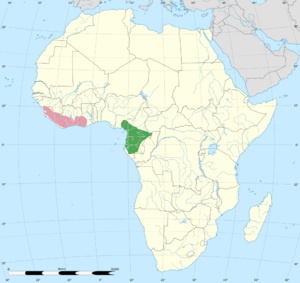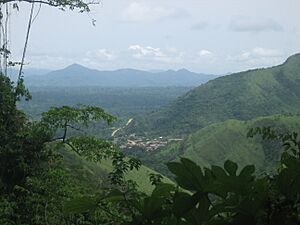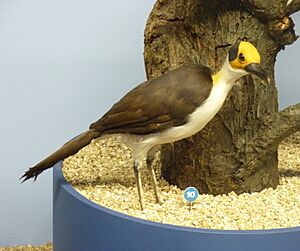White-necked rockfowl facts for kids
Quick facts for kids White-necked rockfowl |
|
|---|---|
 |
|
| Nyamebe Bepo Forest Reserve Ashanti Region, Ghana |
|
| Conservation status | |
| Scientific classification | |
| Genus: |
Picathartes
|
| Species: |
gymnocephalus
|
 |
|
| The distribution of the white-necked rockfowl (pink), along with the grey-necked rockfowl (green) | |
| Synonyms | |
|
|
The white-necked rockfowl (Picathartes gymnocephalus) is a unique bird found in West Africa. It's known for its long neck and tail, and its head has almost no feathers. This bird lives in rocky, forested areas, often near streams and large rock formations called inselbergs.
The white-necked rockfowl has greyish-black feathers on its back and white feathers underneath. Its long, dark brown tail helps it balance. The skin on its head is bright yellow, with two big black patches behind its eyes. Even though it's usually quiet, it does make some sounds, like clucking calls.
These birds mostly eat insects. Parents sometimes feed small frogs to their young. They move through the forest by hopping and making short flights close to the ground. They don't usually fly long distances. White-necked rockfowl pairs stay together and build their nests from mud in caves. They lay two eggs twice a year. This bird can live for a long time.
Sadly, the white-necked rockfowl is considered a Vulnerable species. Its numbers are shrinking, and its home is being destroyed. People are working to protect these birds and their forests.
Contents
- What is the White-necked Rockfowl?
- Sounds and Calls
- Where Do White-necked Rockfowl Live?
- White-necked Rockfowl Habitat
- How White-necked Rockfowl Live
- What Do White-necked Rockfowl Eat?
- White-necked Rockfowl Reproduction and Life Cycle
- White-necked Rockfowl and Humans
- Protecting the White-necked Rockfowl
What is the White-necked Rockfowl?
The white-necked rockfowl is a medium-sized bird. It measures about 38 to 41 centimeters (15 to 16 inches) long. Its long tail makes up about 18 cm (7 inches) of its length. Male and female birds look very similar.
The most striking feature is its head. It's almost completely bare of feathers. The skin on its head is a bright yellow. There are two large, round black patches right behind its eyes. These patches contain the bird's ears. The bird's eyes are large and dark brown. Its beak is strong, black, and curves downwards a bit, looking a bit like a crow's beak.
The chin and throat have a thin layer of white feathers. The neck is long and thin. The back of its neck is mostly bare, showing orange-yellow skin. The upper part of its back is black, blending into a greyish-black lower back. Its legs are blue and quite long. The bird's thighs are very muscular, which helps it move around on the ground. The underside of the bird is a creamy white. In dim light, it can look like it's just black on top and white underneath.
When they are born, baby rockfowl are naked and blind. Their skin is dark brown on top and pink underneath. The black patches on their heads appear about a week before they leave the nest. Young rockfowl look a lot like adults, but their tails are much shorter.
Sounds and Calls
Even though many calls have been recorded, the white-necked rockfowl is usually a quiet bird. Its call sounds like a chicken clucking, like "chuk-chuk-chuk" or "choop-choop-choop." It makes these sounds at a steady rate of eight notes every five seconds, often for at least a minute.
Its alarm call, which it makes more often, is a continuous, low, guttural chatter, like "ow, ow, ow." Adults and young birds also make a long "owooh" call. Young birds leaving the nest can make a loud, quavering whistle to stay in touch with their parents.
Where Do White-necked Rockfowl Live?
This bird is found only in West Africa, from Guinea to Ghana. It's common in some parts of southeastern Guinea and widespread in Sierra Leone and Liberia. In Côte d'Ivoire, it's mostly found near the borders with Guinea and Liberia. In Ghana, it's rare and found in the south-central areas.
The total area where these birds live is huge, about 391,000 square kilometers (151,000 square miles). However, the birds live in small, spread-out groups within this large area. They don't migrate, but they do move around more after the breeding season.
White-necked Rockfowl Habitat
These rockfowl live on steep slopes in both old, untouched forests and mature forests that have grown back. These forests are usually rocky and found in hilly areas up to 800 meters (2,600 feet) high.
White-necked rockfowl often live near flowing streams and rivers. This gives them access to wet mud, which they need to build their nests. Their nesting colonies are usually within 100 meters (330 feet) of a stream. They also seem to prefer living near inselbergs, which are isolated rocky hills. Sometimes, they are seen in forests that have been partly cleared or near cities, but this is unusual.
How White-necked Rockfowl Live
This bird usually stays low in the plants or on the ground near its nesting spots. It moves quickly through the forest by hopping and bounding, then pausing before moving again. It uses its long tail to help it balance. The rockfowl also flies short distances at a low height between vines and trees. It rarely flies for long distances. It can disappear quickly into thick plants or rocks. It can also jump high, sometimes 6 meters (20 feet) from the cave floor to its nest, using its wings only a little.
It was once thought that rockfowl didn't go far from their nesting areas. However, new information shows they travel much wider than believed. They sometimes continue to sleep on their nests even after the breeding season.
These birds are usually alone or in pairs. Sometimes, they live in small groups of three to five birds. They typically try to avoid anything unusual in their forest quietly. But if they know they've been seen, they can become curious and sometimes approach people.
One interesting behavior is when several birds in a colony form a loose circle. Individual rockfowl run at each other, making the other bird move back a little. Then, the first bird might chase the one it charged or another bird in the circle. During this display, a rockfowl might lean forward on a branch, tuck its head between its legs, and spread its wings slightly. This shows its crown to the other birds. This behavior might show they intend to sleep together in a group, or it could be related to breeding.
What Do White-necked Rockfowl Eat?
The white-necked rockfowl searches for food on mossy, rock-covered boulders and in trees covered with vines and hanging moss. It sometimes looks for food by hopping across sand near a stream or even in the stream. This is known because crab remains have been found in their droppings. When foraging on the ground, the rockfowl picks up leaves with its beak and tosses them aside.
They often feed in groups with other bird species, following swarms of Dorylus ants. They pick up insects that the ants scare out of hiding, mostly from the ground. Rockfowl have also been seen hopping from the ground and catching prey in mid-air.
Their diet is varied, which means they can adapt to different food sources. They mainly eat insects, such as cockroach larvae, grasshoppers, earwigs, ants, click beetles, and termites. Besides insects, they eat millipedes, centipedes, snails, earthworms, and sometimes small frogs and lizards. When feeding their young, they mostly bring earthworms, small frogs, and lizards. They also sometimes eat plant material, like mosses.
White-necked Rockfowl Reproduction and Life Cycle
White-necked rockfowl mostly breed in caves. Pairs nest alone or in small groups called colonies. These birds are monogamous, meaning they stay with one mate.
They have two breeding seasons each year. The timing depends on where the birds live and when the wet season occurs. Nesting happens just before and after the wet season, with about 127 days between seasons. The rockfowl reuse their nests and usually repair them a few weeks before laying eggs.
Nesting colonies usually have two to five nests, but one colony had as many as forty nests. Sometimes, non-breeding rockfowl are present in these colonies. These birds might try to kill the young of other pairs to get better nesting spots or mates. Birds in these colonies often chase each other in circles, even through the treetops, which is rare for this species.
The white-necked rockfowl builds its nest from mud mixed with plant fibers. This is unusual for a bird that lives in a rainforest. They collect mud from nearby rivers and streams. They shape the mud into a strong, deep cup that they attach to a cave wall, roof, cliff, or a large boulder. Nests are usually 2 to 4 meters (6.5 to 13 feet) above the ground. The rocks must slope inwards to protect the nest from rain. The inside of the nest is lined with plant fibers and roots.
Wasp nests are often found embedded in the rockfowl's nests. It's thought that rockfowl use the wasp nests as a base to build their own nests on the smooth cave walls. Both parents work on building the nest. One bird collects materials while the other shapes them. Nests are usually built at least 1 meter (3 feet) apart.
They usually lay one or two eggs, most often two, a day or two apart. The eggs are creamy white with dark brown spots. Incubation, when the parents sit on the eggs, lasts for 23 to 28 days. Both parents take turns incubating the eggs.
Baby rockfowl's eyes open after nine to eleven days. Feathers start to grow seven days after hatching. After the young hatch, parents bring them food almost four times an hour. To feed their young, adult rockfowl cling to the side of the nest, fluttering their wings. Some birds use their tails as a prop under the nest for support.
Other animals, like cobras, Nile monitor lizards, squirrels, goshawks, and monkeys, sometimes eat the eggs or young. This means that, on average, only about 0.44 nestlings survive per pair. Parents protect their nests fiercely, and fights often happen. This behavior is rare in other bird species.
The young birds leave the nest after 23 to 27 days. At this point, they look like adult rockfowl but have much shorter tails. They leave the nest by standing on the edge, making a loud whistle, and then gliding to the ground. An adult bird meets them there with insects. Even after leaving the nest, the young birds return to sleep on it with their parents.
White-necked Rockfowl and Humans
In the old stories of the local people in Sierra Leone, the strange rock formations where the white-necked rockfowl lives were believed to be home to ancestral spirits. Because the bird lived there, it was seen as a guardian of these places. This led to a certain respect for the species, even though these old beliefs are mostly gone now. However, in some areas, the bird's secretive habits meant that local people didn't even know it existed.
On the other hand, some hunters from Liberia sometimes catch the young birds for food. Because this species is so unique, it became a symbol for ecotourism and rainforest protection in the 1990s. The white-necked rockfowl has also appeared on many postage stamps from Ghana and Sierra Leone.
Birdwatchers find this bird especially fascinating because of its strange appearance and behavior, and because it's so hard to see. Many bird experts consider it one of the five most desirable birds to see in Africa.
The white-necked rockfowl also played a role in launching Sir David Attenborough's career in 1954. He was the producer of a new TV show called Zoo Quest. The show was supposed to follow attempts to capture animals for zoos, focusing on the white-necked rockfowl. When the original presenter got sick, Attenborough took his place, which started his famous career.
Protecting the White-necked Rockfowl
The IUCN lists this species as Vulnerable. This is because its population is spread out in small groups, its numbers are shrinking, and its home is being destroyed. It is considered more threatened than its close relative, the grey-necked rockfowl. The largest populations are in Sierra Leone and southern Guinea.
It's estimated that only 2,500 to 10,000 white-necked rockfowl survive. The population is decreasing and spread across 32 known locations. Many experts believe the number is closer to the lower estimate. Many of its colonies are becoming so small that they might struggle to survive long-term due to inbreeding.
The main threat is the cutting down of its forest home for timber. While the white-necked rockfowl can handle some disturbance, like one colony surviving even when surrounded by a cocoa plantation, habitat disturbance usually harms their breeding success. Most remaining colonies in Guinea, Sierra Leone, and Côte d'Ivoire are in protected areas. However, most colonies in Liberia and Ghana are not protected.
To help protect this species, Sierra Leone recently made the Gola forest its second national park, Gola National Park. The country also plans to work with Liberia to create a park that crosses both countries to protect the Gola rainforest. In Guinea, the bird's forests are being cut down to make land for rice farms.
Laws exist in Sierra Leone, Liberia, and Ghana to protect this species, but they are not always enforced well. International trade of the white-necked rockfowl is controlled because it's listed under CITES Appendix I. In 2004, BirdLife International created a plan to protect this species. This plan focused on finding remaining habitats, educating local people, and limiting the destruction of its home.
In 2006, BirdLife International received a grant to help put this plan into action. Surveys funded by this grant found more populations in Sierra Leone. Also, park rangers have been trained to protect Sierra Leone's Western Area Forest Reserve. This plan, along with the bird's unique appearance and habits, has made it a symbol for habitat conservation across Africa.
Until 2003, people thought the species was extinct in Ghana. Most of the places where it's known in Ghana are active forest reserves, where logging happens sometimes. Outside these reserves, bush-burning and mining for gold and other metals threaten the remaining habitat. After it was rediscovered in Ghana, the Ghana Wildlife Society started surveying its habitat and putting conservation plans in place.
In the 1950s and 1960s, collecting this species for zoos was a big threat. In Liberia, this practice destroyed several bird colonies. Local people caught the rockfowl using traps. Hunters in Guinea, who already caught rodents and hyraxes at the bird's nesting colonies, sometimes caught rockfowl at night. Most birds caught from the wild died within 24 hours. Even though over 70 white-necked rockfowl were in zoos in the 1970s, breeding them in captivity was rare, and no stable captive populations were formed. Since 1998, no white-necked rockfowl have lived outside of Africa.







